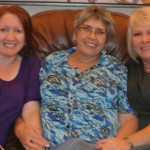Believe it not, I’ve been thinking a lot lately about cooperative community models. Whether it’s a DIY bike shop, a tool lending library, or a place to purchase, prepare and learn about food in community; the underlying principles of cooperatives are the same.
In some shape or form, people are coming together to “cooperate” for their mutual, social, economic, and cultural benefit. Generally speaking, cooperatives imply a formalized governance structure many community groups and organizations are operating under the principals of cooperative governance in an informal way.
So, this past weekend I had the pleasure of travelling to St. Luke’s United Church St. Margaret’s Bay to participate in a full day workshop on Cooperative Greenhouses. The event was put on by Transition Bay St Margaret’s, a group that is part of a network of global communities that are committed to re-building community resilience and reducing Co2 emissions. It’s a transition from oil-based energy production to more sustainable and self-sufficient ways of living. Say for example, the transformation of local food production through Cooperative Greenhouses. Or how, one day, we might be able to eat our landscapes.
The workshop showcased three cooperative greenhouse models, each with their own unique approach to growing food, and community. Bob Cervelli is part of Transition Bay St Margaret’s and told us the story of how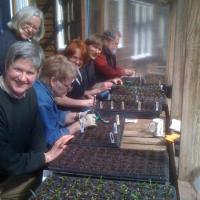 he transformed his own personal greenhouse into the “No-Guilt Greenhouse Coop”. Every Spring it engages 20+ households in growing thousands of seedlings to be distributed among backyard and community gardens across the region. Ah-mazing:) Next up, Mike Carey who works with the founders of the Food is Sacred Coop in the Jollimore (Spryfield) area. Their newly established 20’x24’ greenhouse offers a place for community residents to regularly come together to seed, maintain and harvest fresh vegetables.
he transformed his own personal greenhouse into the “No-Guilt Greenhouse Coop”. Every Spring it engages 20+ households in growing thousands of seedlings to be distributed among backyard and community gardens across the region. Ah-mazing:) Next up, Mike Carey who works with the founders of the Food is Sacred Coop in the Jollimore (Spryfield) area. Their newly established 20’x24’ greenhouse offers a place for community residents to regularly come together to seed, maintain and harvest fresh vegetables.
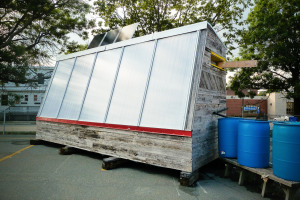 And finally, I presented on the Bloomfield Community Greenhouse. This four season greenhouse offers residents of the North End of Halifax an exciting opportunity to grow greens throughout the winter months, propagate transplants in the spring, and grow warmer weather crops in the summer. It’s passive solar design demonstrates how to collect, store and recycle energy as efficiently as possible and apparently (news to me), it’s also a model of version of a bio shelter!
And finally, I presented on the Bloomfield Community Greenhouse. This four season greenhouse offers residents of the North End of Halifax an exciting opportunity to grow greens throughout the winter months, propagate transplants in the spring, and grow warmer weather crops in the summer. It’s passive solar design demonstrates how to collect, store and recycle energy as efficiently as possible and apparently (news to me), it’s also a model of version of a bio shelter!
After presentations we moved into an afternoon of season extension techniques, and all the “how-to” of setting up a greenhouse, as well as other season extension structures. But at the end of the day, things I took away from this amazing day of knowledge sharing it were this:
1) RESOURCES ARE MEANT TO BE SHARED. When resources are shared, the impact spre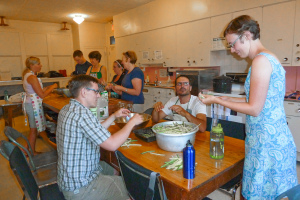 ads far and wide. Much farther and wider than any single individual or household. We need to look at our existing spaces and think about re-purposing, sharing, and new ways of collaboration. Also, we should be thinking about the design of new space through the lens of community gathering, building, and strengthening.
ads far and wide. Much farther and wider than any single individual or household. We need to look at our existing spaces and think about re-purposing, sharing, and new ways of collaboration. Also, we should be thinking about the design of new space through the lens of community gathering, building, and strengthening.
2) MANY HANDS MAKE LIKE WORK. We know this, but let’s meditate on it. Think about how many seeds can be planted, how much food can be grown, or soil moved by 40 hands, versus 2. Whether its friends or strangers, get together with other people to make heavy work lighter, and way more fun.
3) Find a way, or many ways, to TELL YOUR STORY. Write articles, start a face-book page, host a workshop, or scream it from the rooftops. Tell people what you’re doing, share your lessons learned, and be a model for others to replicate. We’re all in this together, let’s learn from one another and create communities of practice.
4) WE CAN ALL GROW FOOD, EVEN J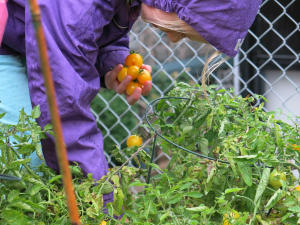 UST A LITTLE.
UST A LITTLE.
I know, that’s a big statement, but there’s something deep inside me that feels that it’s importance. And No, I’m not saying that we all need to grow all of our own food; but if every community or neighbourhood had a place for community food production, at least everyone would have the chance to see what brussel sprouts or broccoli look like in the ground.
Author: Aimee Carson. Community Food Coordinator. Ecology Action Centre


